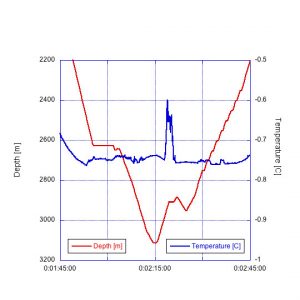
This plot shows sensor depth (red) and temperature (blue) during our last CTD tow-yo through the night from Sunday into Monday. The big temperature anomaly around 2:20 a.m. shows where we believe we intercepted the stem of the hydrothermal plume rising up from the seafloor. Will we get to find the vent, right before our science operations end?
Monday, October 10 – Sunday turned out to be a reeeally long day, but it ended with Champagne at breakfast around 8:00 a.m. Monday before we headed off to bed.
After the excitement of the NUI dive the day before, the day started quietly tempered by the fact that it took many hours to get back from Karasik Seamount to the region of the vent site. We had been due to begin our vent search at 9:00 a.m. Sunday, but when I got out of bed at 10:00 we were still en route and didn’t actually arrive on-site until dinnertime.
Once I was awake, I headed up to the bridge for my daily 11:00 a.m. ice observation duties and had my breath taken away by the stunning beauty of the sky and light outside. After yesterday when we couldn’t see more than 100 meters in front of us, suddenly the visibility was astounding in all directions, with an orange glow lighting half of the horizon as the sun stayed just out of sight.
As soon as my chores were done, I rushed back to the lab, grabbed my camera, and urged Mike and Casey to come on deck and look. Only then did they remind me to check the temperature outside: -14°C (7°F) and falling. Time to put on warm jacket, hat, and gloves, first!
All afternoon, I was busy (or at least, my computer was) transferring 323Gb of video from the NUI team’s computer. Indeed, the video feed from NUI Dive 16 takes up more space than the entire hard drive in my five year-old laptop (my back-up is even older), but with judicious use of an external hard drive, I was able to sift through and pick out some freeze-frame highlights of the things we found to share at the science meeting in the afternoon.
Then, finally, it was both dinner time and time to start the OFOS dive to search for the vents. Autun, Laura, and Simon had worked out that our latest barrier to success may have been that we were missing a lucky number 7—in the number of people who have been gathering on deck to continue the tradition of the CTD team’s port-on-starboard ceremony to toast the health of OFOS, the ice, and the oceans. So I was invited out to join them.
With that done it was time to head in while OFOS was lowered to the seafloor. Many hours later, we had driven round and round, etching a path over the seafloor that look as random as a toddler’s doodling—or maybe a Jackson Pollock. Either way, we spent an excruciating amount of time feeling like we must be very close to being in just the right place, but with video feeds that could only see a few meters to either side, the active vent site that we know must be there remained just out of sight.
Eventually, the ship’s drift and the shuffling ice got the better of us and OFOS was pulled away from our target area. We could only watch as the live video feeds changed from scenes of old, rotting sulfide chimneys and mineral deposits to old, cold rocks draped in biologically generated sediments settling from he upper ocean. And then it was time to come home.
Next up, it was time for Maren, Janna, and me to try our luck with the CTD. At a meeting right after NUI returned to the ship on Saturday, the three of us, together with Jill and Kevin from the U.S. and Gunter and Massi from Germany, had planned out exactly what a perfect CTD station to collect missing data and water samples would look like. After a 30-minute nap, I was back in the winch room to see if that plan would work.
At 4:00 a.m., we launched the CTD and by 4:30 things were going horribly, horribly wrong. In just a half hour, the wind picked up AND changed direction so that, instead of following a path that would take us right over where we wanted to go, we were heading in a completely different direction at twice the speed we anticipated. Worst of all, the ice was closing in all around the ship and threatening to cut the cable holding all our sensing and sampling gear beneath the ship.
Michael on the bridge was not enjoying himself, but did what he could to open up a pool of water on the starboard side of the ship and keep the science equipment safe. When he called down to say we could continue lowering away, we instead decided that it was time to pull everything up on deck, move the ship, and start again from a better location.
The second pass worked like a charm. We started out one kilometer (0.6 mile) south-southeast of the site and drifted at one-half knot (about 900 meters per hour) for just less than an hour so that we would have time to lower the CTD to the depth of the plume about 15 minutes before we arrived over our target. Just as we had hoped, we descended into a plume laden with particles at exactly the depth expected. After 15 minutes or so, the signal transformed into a plume that did not contain any particles, but that showed large redox anomalies, which meant we had moved from old plume material into a region containing younger, fresher material.
Without delay, we lowered the CTD down to just 10 meters (33 feet) above the seafloor and then began pulling it back up again, ready to collect the best samples we could. Boy, did we luck out. Just 200 meters (660 feet) above the seafloor our sensors showed that we were in a plume of young, particle-free, and chemically fresh material that was much closer to the seabed than anywhere else we had seen hydrothermal plumes all cruise and that was also hotter than anything else we had seen by a wide margin.
Because we are in the Arctic, that still meant the water was cold (below freezing), but it was very clearly warmer than any other water we have sampled at the same depth throughout the past three weeks in this area, that it was obvious—to us, at least—that we had intercepted the buoyant stem of the plume rising directly above the vent site.
Why is that important? Well, the normal hydrothermal plume that was detected here as far back as 2001 can be traced for more than 10 kilometers (6 miles) through the water column, whereas the plume that we have been pursuing for the past three weeks, while more closely localized, can still be found one kilometer in all directions. By contrast, the rising stem above a hydrothermal plume is a much narrower target—less than 100 meters in any direction. That was why Maren, Janna, and I ended our night happy on Monday, heading off to bed just as a horde of other geochemists rose for an early breakfast before setting to work analyzing the samples we had just collected.
We’ll be looking forward to learning the results of their measurements when we wake up after lunch. Then we expect to have time for two more attempts to film the seafloor, starting late on Monday night. Whatever happens, the captain insists that we have to leave by midday Tuesday. We have just eighteen hours left to get the job done.
But wait, you say, how long can it take to search an area the size of a football field? Well, here’s the catch: Imagine you wanted to find something the size of a small car in the middle of that field. Then imagine it is night, all the stadium lights are turned off, you are in a hot air balloon two miles up, and not only is the stadium dark, but the entire city around it is suffering a power outage so that you have no landmarks to guide you. Now, take a piece of line, attach a GoPro camera to it, and lower it out of the basket of the balloon. You have 8 hours to find the car and photograph it. But first you have to make sure you are over the right city—and that you are in the right part of the city, so that you can be sure that you are lowering your camera over the right stadium. But be careful of the financial district—if you smash into the skyscrapers they will really mess your camera up, big time. Oh, and did I mention that 30 mph winds are blowing your balloon in a direction you don’t want to go?
So good luck with your mission! And if, after eight hours, you have not succeeded, do not fear: you can take a four-hour break start all over again.

